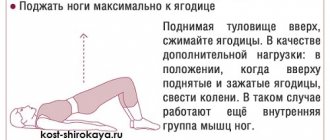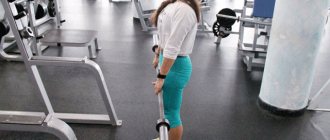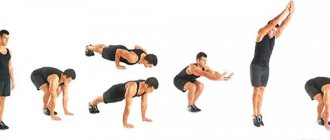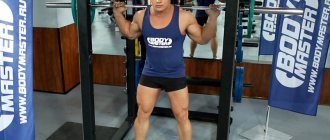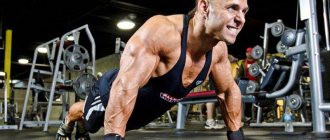Home ▸ Articles ▸ Workouts ▸ Training with ropes for CrossFit
Battle Ropes training has been a pretty hot topic in the fitness world for the past few years. This unique exercise tool has attracted many fans, and today such ropes can be seen everywhere from Adidas advertisements to UFC videos. They are considered to be best used in CrossFit.
In this article, you will learn both the basic principles and the latest CrossFit rope training techniques that have been used for the past few years.
Benefits of rope training
- Later formation of lactic acid in the upper body, which comes from long-term intense training with ropes. Accordingly, the intensity can be maintained for up to 5 minutes, and this is unique.
- Ropes fans are funny . Many people hate the gym, and not because they are lazy. It's just boring in a big typical gym and not much has changed in the last 30 years. And the ropes in training are like a breath of fresh air, invigorating and making you return to this “game” again and again.
- Developing mental endurance . When people start rope training, maintaining intensity for 1 minute seems like a pipe dream, but consistent training helps them overcome mental barriers, reach that goal, and gain new perspective and confidence.
- Finding balance. If you carefully observe the movements during rope exercises, you may notice that one side of your body may move differently than the other. This gives rise to a feeling of uncoordination. However, with continued training, these differences disappear. Gradually you will notice that your right and left sides begin to balance.
Waves with ropes[edit | edit code]
Ropes can also be used in a horizontal plane. Depending on the length, weight and thickness of the ropes, exercises with them will be aimed at developing endurance and/or strength. Technique Tips:
the legs are bent, the back is straight, the chest is protruded, the head is raised, the gaze is fixed at the horizon level.
Options:
wave-like movements with one or two hands - weak, medium or large amplitudes; side waves intersecting horizontally or performed with a reverse grip; and finally, side lifts (star). As your coordination improves, you can add legs.
Wave-like work with ropes allows you to train the endurance of the cardiovascular system in general in an original manner, as well as develop the strength of the back and arm muscles.
- Keep your legs slightly bent
- All of these exercises can be modified by moving your legs forward, backward, in 6-steps or lunges
- Control the position of your back, even if it is not directly loaded
- With both hands at the same time. Ordinary waves with different amplitudes
- Throwing ropes from one side to the other using a reverse grip. Cross waves with ropes
- Exercise "star" with ropes
Summary table of the different effects of rope exercises
| The cardiovascular system | Force | Coordination | Plank | |
| Regular waves | ** | ** | * | * |
| Weak amplitude | *** | * | ** | * |
| Large amplitude | ** | ** | ** | ** |
| With both hands at the same time | * | *** | * | ** |
| Reverse grip | * | ** | ** | *** |
| Horizontal crossing | * | * | *** | ** |
| Star | ** | * | *** | * |
Examples of rope training[edit | edit code]
Workout 1 - “Roller Coaster”
- 3 x 10 box jumps - 3 x 10 tuck jumps - 3 x 10 burpees
Perform in combination for 10 minutes: 20 seconds of regular rope waves - 20 meters of sprint (there/back 2x10 meters) - 10 burpees - 20 seconds of waves with both ropes with arms - 10 tuck jumps - 10 star burpees.
- 10 x 30 seconds of fast running - 30 seconds of slow running.
Workout 2 - Multiple Ends
Perform 6 approaches in a row as quickly as possible: 10 tuck jumps - 10 rope waves with two hands - 10 burpees - 10 rope waves with large amplitude - 400 meters run.
Workout 3 - SONIC WAVE
Make waves as quickly as possible for 10 seconds with a minute start for 10 minutes.
10 rope waves with two hands - 5 burpees - 50 meters sprint at maximum speed. Recovery 3 minutes. 10 approaches.
How to use ropes for exercise
- Relax. Learning to relax under stress is vital. Many people grip the ropes tightly and strain their bodies, which leads to fatigue quickly. Grip the rope lightly, relax your arms, shoulders, torso, and even your face—you'll be able to move faster and maintain intensity for longer periods of time.
- Breathe. It has a lot to do with learning to relax. CrossFit rope exercises do not have a resting point that allows you to relax and breathe in a coordinated manner like other workouts. Beginners tend to hold their breath when working with ropes and damage it. Try to combine your movement with your breathing, as your speed and intensity increase, your breathing should also increase.
- Full body workout. While most CrossFit rope exercises are considered upper body exercises, you should always use your entire body to increase power and efficiency. The legs and hips play an important role in generating energy to and through the arms. This is important for any sport, especially athletics. As you make waves, be aware of your feet, legs, hips and shoulders. Make sure you are not standing too rigidly and that all areas of your body are active.
Rope climbing[edit | edit code]
In the family of "pulling" movements, rope climbing occupies the position of patriarch, but at the same time... it is, without a doubt, one of the most effective exercises. Like pull-ups, it requires deep involvement of all muscles of the pulling group. But rope climbing has additional benefits:
- More pronounced effect on the cardiovascular system;
- Gaming aspect;
- Elements of risk;
- Lateralization;
- More complete scope of work.
Intensive use of the teres major and latissimus dorsi muscles, along with the entire chain of arm flexors (biceps, but also forearms) and, finally, the tight trunk plank and shoulder girdle stabilizers, makes it one of the most effective exercises for developing the upper limbs and trunk.
All rope climbing exercises included in the workout are not necessarily performed as high as possible; doing repetitions at low heights is sometimes much more difficult!
Exercise technique[edit | edit code]
We start sitting, squatting or standing, taking the rope as far as possible, with a straight hand if possible. Pull your body as high as possible (ideally, your arm and hip should be almost at the same level) before throwing your other arm forward and repeating the action on the other side.
Rope climbing. Debut[edit | edit code]
The first steps in rope climbing can be difficult. Indeed, many debutants experience all the suffering in the world, even just to stay suspended on a rope. If this is your case, you will need to organize your training in the first weeks so that you have time to develop both strength and technique. The first effective exercise is an exercise with a rope on the floor
.
Lay the rope out on a surface that is not too sticky or too dirty. Lie on your back on one side and attach a kettlebell or short barbell to the other side. Then simply pull the weight towards you. As you progress
, increase the weight and then when you feel ready, try the vertical rope again.
Another possibility is to develop your specific strength
thanks to eccentric work. By standing on a board or bench near the rope, you can practice your descent while controlling your speed. This way you remove the overwhelming part of rope climbing, but at the same time practice on the rope. Over the course of several sessions, the reserves of strength acquired during this eccentric work should allow you to move forward.
And finally, the third possibility,
"free" yourself from your own body weight - stand with both feet on the ground This exercise is called the "endless rope" and it requires the participation of a partner. Throw the end of the rope over the horizontal bar. It is this end that you will pull with all your might, while your partner will slow down the gradual unwinding of the rope.
Examples of rope training[edit | edit code]
Workout 1 - On a Stiff Rope
- Perform a circuit behind a friend as quickly as possible 5 sets of: 2 deadlifts - 2 rope climbs - 20 upper torso straight crunches -20 upper torso extensions
Workout 2 - tightrope walker
- Front Squats 5 X 10 70% max with 1 minute max recovery
- 8 series of rope climbs: normal ascent - 6 meters, stopping for 5 seconds every two meters - normal ascent - 6 meters slowing the descent as much as possible - normal ascent - 6 explosive meters (climb as quickly as possible) - normal ascent - stay suspended as long as possible.
- plank while rolling the barbell: 4 x 10 repetitions.
Workout 3 – “running with a rope”
- Per minute start for 12 minutes: 1 push - then, without lowering the barbell to the floor, 2 front squats - 5 meter rope climb
- Then bench press 5 X 5.
Exercise "Waves"
Waves are usually what you see on YouTube in commercials. The most challenging aspect of the wave series is the zero downtime when doing the exercises correctly. Waves require 100% commitment.
There are different variations of these exercises, including different intervals for specific times and/or distances. Time, distance, number of repetitions - you can constantly change different indicators for different workouts and goals.
When trying to do a wave series for the first time, 20 seconds will seem like an eternity, but with regular training, people adapt quickly and can maintain a constant pace and intensity from 5 minutes to over 45 minutes. As a recommendation: build up to 10-20 minutes, and then work up the intensity and speed.
A series of waves is performed in a plank position, standing, kneeling, sitting. As you move from standing to kneeling, it becomes increasingly difficult to complete the waves. Adding different movements (squats, lunges, jumps, lateral movements and more) can make a basic movement very difficult.
The faster you progress, the harder and more intense the workout becomes. Try to maintain a pace of 120-150 alternating waves per minute and listen to how you feel.
What exercises can you do with a rope?
As we said above, the essence of training with ropes is high intensity. You should perform three sets of each movement, working for half a minute on each. The pause between sets should not exceed thirty seconds.
- Double wave.
You need to take a half-squat position, while the spinal column should be strictly vertical. Place your feet shoulder-width apart, and your toes should point forward. There should be a rope in each hand, after which you begin to move down and up, thereby creating wave-like movements of the ropes. The body should always remain vertical and the rhythm of the movement should be even. The movement is designed to strengthen the muscles of the shoulder girdle and forearms. - Intermittent waves.
This rope exercise is very similar to the one we discussed earlier. The difference is that you should not move your arms simultaneously, but alternately. This allows for more active use of the body stabilizers compared to a double wave. - We pick it up and throw it.
The initial position corresponds to a double wave. Taking the ropes in your hands, pull them tightly. Having lifted the projectile up, sharply throw the ropes down. The ropes should be thrown alternately from right to down, and then from left to down. The muscles of the forearms, arms and abs are actively involved in the work. - Double jump rope.
Surely some of you jumped over a double rope as a child. To perform this exercise with a rope, you should pick up the apparatus and make movements in a circular path. The right hand should move in a clockwise direction. And the left is against it. After each set, you should change the direction of arm movement. - Double jump rope and alternating back lunge.
This exercise is the most difficult in the entire rope training program. This is due to the fact that it combines double alternating waves (the first and second exercises). Using your arms, you should perform a double wave movement and alternate lunges with your legs backwards, touching the ground with your knee joints. This movement allows you to actively work out almost all the muscles of the body.
You will learn about the two most popular exercises with a rope from this video:
To feel the full power of this simulator, just a couple of exercises are enough. But…. Variety is what makes training fun. With a little creativity, the rope can become one of your favorite exercises in the gym.
The basic movements with a rope are creating a wave. The complexity and variety of exercises is created by different body positions and different grips. The advantage of training with a rope is that when performing exercises, the muscles of the entire body are in constant tension and active work. The body is not given the opportunity to relax and adapt to the monotonous load.
The distribution of the load throughout the body depends on how the exercise is performed. With this, you can conduct a full-fledged training to develop strength and endurance of different muscle groups at the same time - arms, legs, shoulder torso, abs, back. Burn more calories, gain muscle mass, improve functional strength - it's all possible with CrossFit ropes. In addition, it is a powerful tool for cardio training and strengthening the cardiovascular system. With such training you get tired instantly, but at the same time the muscles are worked out very well.
Perform each of the following exercises for a specific period of time. Beginners should start with 15 to 25 seconds per movement, and if you are a more advanced athlete, challenge yourself for 30 to 45 seconds.
1. Alternating waves in a half-squat.
Bend your legs into a half-squat position, pushing your hips back as if you were about to sit in a chair. Place your body weight on your heels and keep your chest upright.
Forcefully swing your arms up and down below your knees to get maximum power. Try to maintain consistent waves throughout the movement. Vary the waves from large to small by changing the amplitude of the vertical movement of the rope. Small, fast waves are aimed more at working the arm muscles. Larger waves will help increase overall power due to more active work of the body.
2. Double wave.
The starting position is the same as in the previous exercise. But now we move our arms up/down simultaneously, trying to maintain the wave throughout the entire exercise. Again, we alternate small waves with large ones either in one approach or in separate ones. Similar to the previous movement, the smaller and faster the waves, the faster the speed of the fast-twitch muscles. Big waves will help work the entire core and develop strength.
3. Jumping with powerful claps.
This intense plyometric rope exercise will improve your explosiveness.
Making sure that the rope is loose and not tight, jump up from a half-squat position, while taking a deep breath and swinging your arms with the rope above your head as much as possible. And, landing again on your haunches, as you exhale, slam the rope on the floor with maximum force.
It is important to breathe correctly during the exercise, because... this helps strengthen your core muscles. Perform this exercise several times according to the instructions provided.
4. Rotation from side to side.
The target of this exercise is the core and leg muscles.
Holding the ropes in your lowered hands at your right hip, forcefully move the rope towards your left thigh. At the same time, turning the right leg and knee inward. As soon as the rope reaches the floor, immediately send the rope through the body back to the right hip, turning the left leg and knee inward. Generate strength and power from the floor up through your legs, core and arms.
5. Complicate the previous exercise.
Lunge with your left leg at a 90-degree angle. The right one is extended back slightly above the floor. The body is straight. While holding the position, throw the rope over your left knee from side to side continuously. Perform the next approach on the other leg. In this exercise, the load on the leg muscles is even greater. In addition, the stabilizer muscles that keep you in balance are under load.
6.
Standing rope throw.
Try jumping with the added resistance of a gym rope
, which will first of all force the muscles of the shoulders, back, arms and legs to work in an enhanced mode.
Starting position: feet shoulder-width apart, rope loosened. Make sure the position is stable. The strength coming from your legs will help you raise your arms with the rope high above your head and throw it down.
If you are unable to use your legs, this exercise will be much more difficult than it should be. Then try to do the entire movement once, and then prepare yourself for the next repetition.
7. Jumping with alternating waves.
Before you begin, concentrate on the position of your legs. This is important for maximum strength and stability throughout the exercise.
Perform jumps with alternating legs, landing on a bent leg in a forward lunge. At the same time, the arms move up/down, clapping the rope on the floor.
Start slowly until you are able to control the entire stroke. Once you have mastered it, you can increase your speed by repeating the jumps without intermediate pauses.
8. Exercise to work the upper body and core.
Feet shoulder width apart. While inhaling, swing your arms above your head, throw yourself down, squat down, resting your hands on the floor with the rope, exhale, throw your legs back into the plank position. Then we jump to bring our legs back to our hands and stand up to repeat.
9. Running in place.
This exercise is great for improving your agility. Running forward/backward with light, quick steps on your toes while simultaneously raising your arms up/down, forming waves. Change the amplitude of the waves to short/long. Try to maintain movement with the rope at a distance of about 3 meters.
10. Throws while sitting.
This exercise is performed while sitting. Start in a position with your heels touching the floor. Turning your body from side to side, throw the rope from one side to the other, through your legs. The head is slightly tilted forward, the chin is down. In this exercise, the muscles of the shoulder and abdominal muscles work intensely. To complicate the exercise, try doing the same thing, but with your legs torn off a few cm from the floor surface. This is not an easy task!
11. Plank with a wave.
The next exercise is for advanced athletes.
Challenge your abs and arms with a challenging exercise for both strength and balance.
Starting position - “plank”, leaning on the floor with one hand, holding the rope in the other. Keep your feet shoulder-width apart and place your weight in your heels for greater stability. The spine is straight. Once you have established the correct plank position, begin moving your arm sideways at a fast pace.
Don't let your hips sag or tilt to the side. Imagine that you have a glass of water sitting on your lower back and you don't want to spill it. This way you keep your hip level. Repeat the exercise with the other hand for the same period of time.
12. Side plank with rope.
The oblique and transverse abdominal muscles are extremely important, but they are not always given due attention. The side plank is a phenomenal rope exercise.
to train these muscles. Tie one end of the rope to a weight and leave it at the far end of the room. Pull the rope and at the other end, free from the weight, stand in a side “plank”, leaning on your elbow. Take the rope in your free hand and pull it behind your back until the other end with the weight is near you. Then pull the loaded end again to the far corner, change the bar to the other side.
During the exercise, monitor the position of the body, do not allow it to sag or lean forward.
Functional training with crossfit rope
Recommended for Football, Hockey, Rugby and anyone else who needs powerful training tools.
Sometimes it is very useful to feel in limbo.
And now we are not talking about psychological awkwardness, but about a simulator that develops physical dexterity. And also coordination, balance and muscles of the whole body.
Suspended training has been around for a long time - exercises on ropes were described back in the 19th century, in books on the physical education of boys. I became acquainted with this type of training thanks to the popular TRX loop trainers.
With the help of loops, the usual and monotonous push-ups, pull-ups and lunges can be made much more varied. And fitness fans have long appreciated this. We also came up with a lot of new movements for balance and stretching. As a result of functional training with loops, the muscles of the whole body are worked out (especially the central part, including the stabilizer muscles), coordination is improved and flexibility is developed.
The method that allows you to achieve such results is incredibly simple: it consists of a pair of slings with loops into which arms or legs are threaded.
The loops can be connected to each other or be separate so that they can be hung parallel to each other at a certain distance. With separate loops it is somewhat more difficult to align the length of the strap, but exercises with them are more comfortable.
This equipment is attached to any horizontal support - to a horizontal bar or to a strong tree branch. In other words, you can exercise with loops not only in the fitness center, but also at home or outdoors. You can take the loops with you on a business trip, on a trip or to the country.
Exercise “Rope Pulling”
These are incredible exercises, but they are not very popular, although they are simple and effective. They challenge the entire body and help build fundamental strength. They are also very effective for those who want to develop more upper body strength.
Like waves, stretching can be done while standing or kneeling, manipulating variables such as time or distance. Want to stretch a mile? Pull out 53 lengths of a 30-meter rope, that's a mile or 1.6 km. You can simply pull at a distance, for example, while sitting.
Circuit training with loops for men
Reverse push-ups
We attach the slings of the projectile to the support at a distance slightly wider than the shoulders. We grab the handles and pull ourselves up, moving to a hanging position - the handles are at the hips, straight arms hold the body vertically. Bend your elbows and lower yourself down. You can bend your knees slightly so as not to touch your feet to the floor.
Hanging pull-up
We fix the handles at head level. Grasping them, we hang, bending our knees and moving our shins back so as not to touch the floor. Palms face forward. We pull ourselves up, bending our arms and smoothly returning to the IP position.
One leg squat
We lower the handles below knee level, insert one of the feet into the handle, while the other is slightly bent. hips with the floor, while simultaneously moving the leg in the handle back and the same arm forward. After squatting the required number of times, change legs.
Exercise “In pairs”
Some people prefer to work alone, but people's performance generally improves when they have good training partners. CrossFit ropes allow you to do a lot of fun exercises for groups of people.
Partner exercises challenge you not only to overcome the friction or weight of the rope, but also the energy created by your partner. Simply holding a rope becomes much more challenging and a completely new sensation compared to solo exercises, plus it's more challenging and fun.
Once you have mastered the basics, you can move on to more advanced levels of exercise. Try it and don't be afraid of anything!
Who is suitable for training with loops?
First of all, for those who like to experiment and quickly get tired of routine. With such a simulator, even familiar exercises become new. Performing them in a suspended state, a person receives very unusual sensations.
The loops are suitable for both men and women. Men, of course, will not be able to gain weight on this machine, but they will strengthen their torso muscles and make their body more prominent. And women will not only strengthen the muscles of their arms and chest, but will also master two of their least favorite exercises - push-ups and pull-ups.
Both beginners and experienced athletes can practice with loops.
But in any case, you first master basic exercises, which then become more complicated. First, the trajectory of movements and amplitude are worked out, because they are much more difficult to control while hanging on loops.

